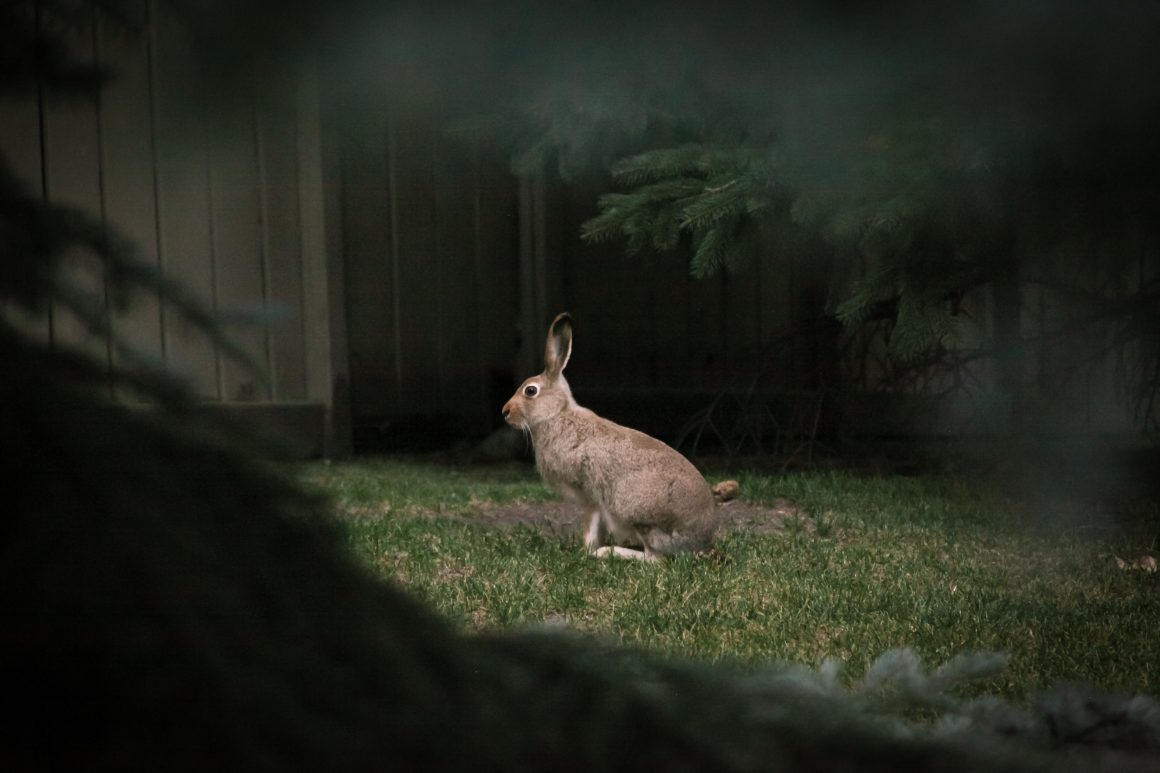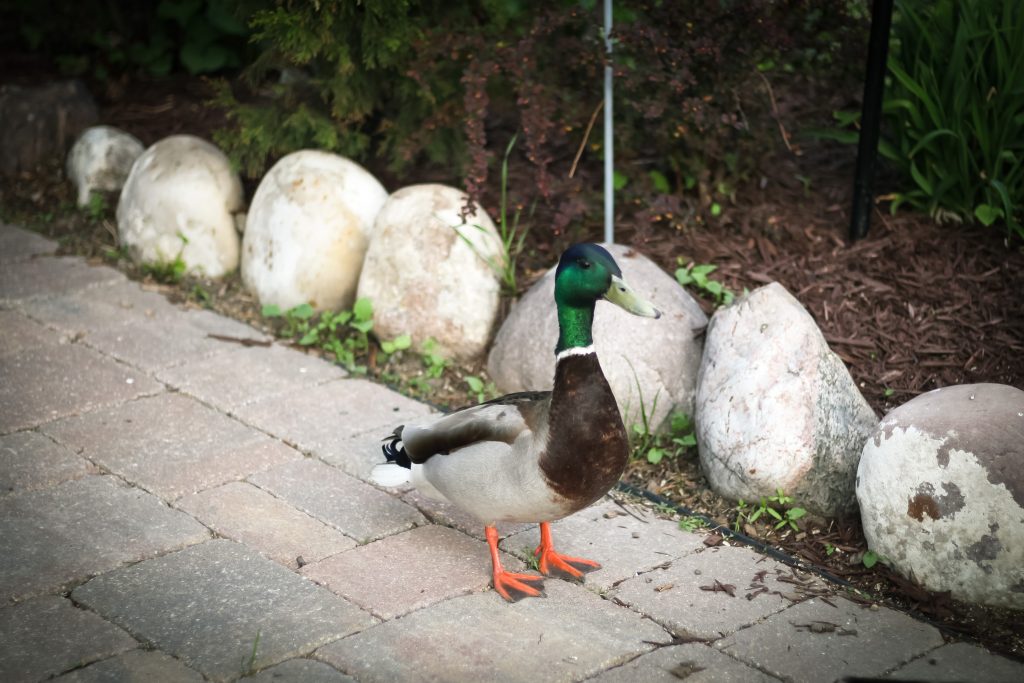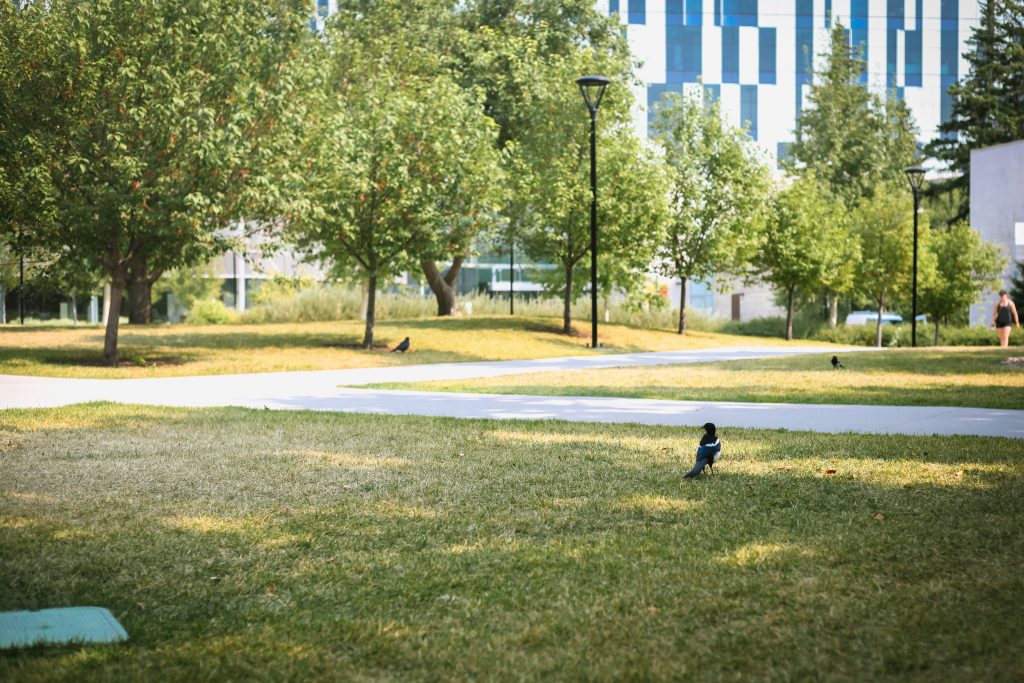
The critters that call campus home
By Sean Willett, September 4 2017 —
Nights at the U of C may have few students, but they are still filled with life. Rabbits graze in the twilight, ears raised in a state of constant alertness. A pair of black-capped chickadees tend to their nest. Moving from bush to bush, a coyote attempts to remain unseen. The soft call of a great horned owl disrupts the silence.
An entire urban ecosystem resides within the U of C’s campus, with dozens of animal species living and dying among its glass- and quartz-covered towers. Many animals — such as ducks and migrating songbirds — stay only briefly, using campus as a pit stop on a longer journey. Other species are almost always present, even if they’re rarely seen by humans.
But some of these animals are impossible to miss, seemingly as numerous as the students themselves. U of C associate professor of zoology Jessica Theodore points to the campus’s white-tailed jackrabbits as a prime example.
“They’re everywhere, and they’re highly visible to humans,” Theodore said. “They tend to wander all over campus and they’re in the size range we tend to notice.”
The jackrabbits are particularly noticeable in the fall and spring, when the colour of their changing coat may not match their surroundings. Due to Calgary’s unpredictable weather, it’s not uncommon to see bright white rabbits hopping around a snowless campus.
“I suspect they get as surprised by the weather here as we do,” Theodore said.
Other well-known campus inhabitants include the house sparrows that search for scraps on the MacHall patios and the pair of peregrine falcons that make their nest on Craigie Hall every spring.
“A lot of people also noticed a couple years ago when great horned owls took up residence by the CTrain station,” Theodore said. “The university had to barricade off the area to prevent people from getting dive-bombed by owlets, which is pretty funny. When they were around, I didn’t see a single jackrabbit for months.”

However, these high-profile species are the exception, not the rule — most animal species on campus are too small or reclusive to be spotted by students.
“You probably don’t notice the bats or the deer mice that are almost certainly here,” Theodore said. “There are likely ground squirrels on the western side of campus, and possibly even some red squirrels. These mammals are easy to miss. They’re skittish, small and are often nocturnal.”
Coyotes are another difficult-to-spot species that visits the U of C. Though these small canines are occasionally seen moving in and out of shrubbery on the fringes of campus, U of C geography professor Shelley Alexander explains that coyotes often go completely unnoticed.
“They are often present even when we do not know they’re there,” Alexander said. “Coyotes are using spaces that we are using at the same time we are there, but they are not always engaging with us. Some people have referred to them as the ghost dogs of the city. Coyotes are there and living out their lives, trying to keep their distance from people.”
While the thought of sharing the U of C’s campus with coyotes may unsettle some, Alexander said that they are nothing to fear. Instead, they should be viewed as any other urban animal — albeit one that should never be approached or fed.
“A carnivore like that showing up in city makes us confront this idea of what species belong here and upends our expectations,” Alexander said. “People feel like coyotes don’t belong here, that they’re out of place. There’s a lack of understanding and awareness that we are actually in coyote habitat and that coyotes do engage in our urban networks. And it’s totally natural, given the coyote’s ability to adapt to these kinds of environments.”
Despite this, large predators like coyotes and owls are hard to find on campus. Instead, as with most parts of Calgary, the U of C is dominated by generalists. These animals — magpies, pigeons, squirrels and other urban survivors — can be found in even the city’s densest neighbourhoods, and are able to succeed due to their ability to exploit human-built environments.
“There are a lot of things that can make urban environments hospitable for certain species,” Theodore said. “Eastern grey squirrels do extremely well in urban environments and I suspect some of it is that we provide lots of ways for them to get around. They love electrical wires and to move around the landscape from high up.”
Unfortunately, not all animals have a squirrel’s ability to cope with cities. Native species like deer, porcupines and even occasional campus visitors like coyotes and owls have a difficult time surviving in spaces as small and well-developed as the U of C.
“The university is a very managed habitat compared to Nose Hill Park or other parks in the area,” Theodore said. “So you’re only going to get a subset of the species that could live here. You’re never going to get the full set you would see in a more wild landscape.”
While we’ll likely never see a fully wild ecosystem at the U of C, there are ways to bridge the gap between campus and the natural world. U of C environmental design professor Mary-Ellen Tyler believes that urban design should keep other species in mind — and that doing so would ultimately benefit us as well.
“Humans live in a pretty complicated life support system,” Tyler said. “The idea that our species can separate ourselves from other lifeforms and create some kind of technological bubble is, in my opinion, not very thoughtful, because we are interconnected with everything else. And I think we’ve been in denial, pretending that we don’t have to worry about that stuff.”
“Spaces where we’ve really upended the ecosystem can be really out of whack,” Theodore added. “There are fewer predators, more insects and more diseases. There’s a multitude of impacts. More diverse ecosystems, more native ecosystems, are generally healthier for us.”
Tyler studies ecological design, a field that works to better integrate wild ecosystems into urban environments. For example, she argues a problem with city design — and with the U of C campus — is a lack of connective areas linking urban green spaces.
“We have eliminated those kinds of pathways and connections with city-building that doesn’t take those things into consideration,” Tyler said. “Now we have these isolated areas like Nose Hill and the campus, where animals aren’t able to move in a wide enough area to meet their needs.”
This type of isolation can create conflicts between humans and other species, as they end up both competing for the same spaces. Tyler believes that this kind of conflict can be averted by connecting smaller green spaces together and that doing so would help increase biodiversity in areas like the U of C campus.
“We need to start creating these opportunities for connection,” she said. “Or we are only going see pests and generalists that can cope with the environments we’ve created.”
However, this type of urban design has its risks. More wildlife and wild spaces in urban areas means higher maintenance costs, more vectors for pest species and more dark, potentially dangerous places in our cities.
“If I’m a student walking alone on campus in the middle of the night, I don’t want to pass by an area where someone can hide and jump out and hurt me,” Theodore said. “Frankly, for women on campus, that’s a big deal.”
While these issues are not insurmountable, they do require large-scale ecological design projects to be carefully planned and rooted in evidence. Students likely won’t see extensive changes like this any time soon, but there are ways the U of C’s campus could be made more immediately friendly to wildlife. For example, Theodore suggests we start with one of the most common design elements on the U of C campus — windows.
“We are very bad at managing windows for wildlife,” she said. “Birds will run into windows, and we like to put little spikes and things to prevent birds from nesting.”

Theodore also singled out the U of C’s over-reliance on lawns to fill campus green spaces.
“Lawns really restrict biodiversity,” she explained. “It’s why we have so many bunnies, because they are one of the few animals that can live off of that kind of grass. If we had more seeding plants, some shrubbery — any kind of mixed grass ecosystem on campus — we would have a more diverse fauna.”
According to Tyler, landscaping efforts such as this could provide big benefits to U of C wildlife at a relatively low cost. For example, the university could provide more flowers for native pollinator species and could plant trees in clusters to provide better habitats for migrating birds.
“Right now, you go out on campus and see single trees,” Tyler said. “And very seldom in the natural world do you find a single tree. We need to think a little differently about landscaping — it can still be ornamental, but it can also be practical.”
This philosophy of ecological design — one that blends the ornamental with the practical, the human with the non-human — is still a relatively new concept in the world of urban planning. Many people still view urban wildlife species as pests that should be removed and building spaces that welcome these animals with open arms will likely be contentious.
For this kind of design to succeed, people will need to change the way they view their animal neighbours and learn to coexist with a more diverse palette of species. For Alexander, there is no better place to start this change than a university campus.
“We should use the campus as a learning lab for this type of design,” Alexander said. “Use it as a learning opportunity to build engagement with the environment, to build pride in our campus. We can empower students and faculty to understand what should be in our campus ecosystem and how that ecosystem fits into a bigger world.”
